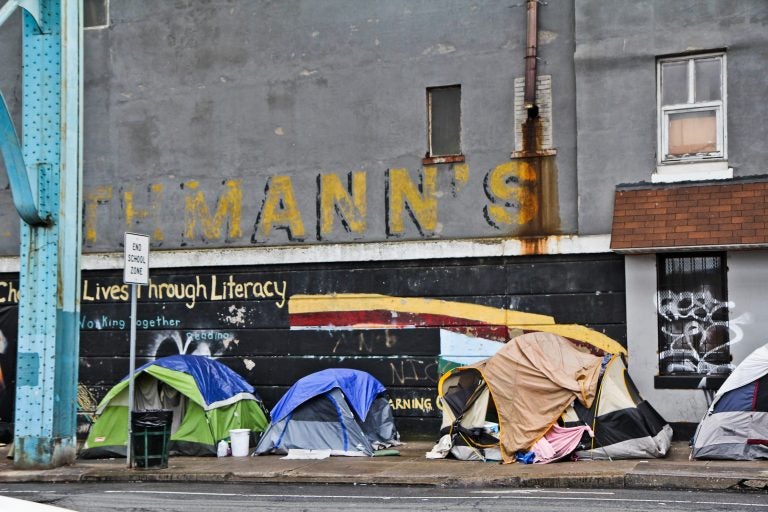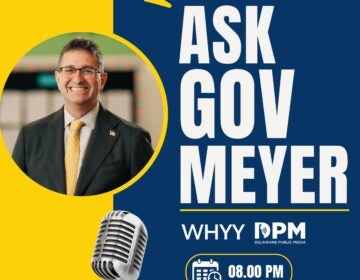Philadelphia aims to decrease homeless ranks by 5 percent annually over 5 years
'Roadmap to Homes' calls for expanding the city’s stock of housing and job opportunities — and improving communication and coordination with hundreds of service providers.

People were evicted from an encampment at Kensington and Tulip Streets in May. The city of Philadelphia released its “Roadmap to Homes” Wednesday, a plan to reduce street homelessness by 5 percent every year for the next five years. (Kimberly Paynter/WHYY)
Make homelessness rare. Make homelessness brief. Make homelessness nonrecurring.
Those are the three overarching goals of Philadelphia’s new strategic plan to provide better, hopefully long-lasting, help to the thousands of people who experience homelessness in the city each year — and reduce the number who need it.
“It’s about equity, and it’s about love and caring for our fellow human beings,” said Mayor Jim Kenney Wednesday at a news conference announcing the five-year plan.
As of January, 5,788 people were living on the street, in a shelter, or some form of homeless housing, according to city statistics.
“Roadmap to Homes” looks to help those people — and many more — by expanding the city’s stock of housing and job opportunities, as well as improving communication and coordination with the hundreds of service providers that partner with the city.
To help connect more homeless people with housing, the city will develop strategies for moving people from permanent supportive housing to affordable housing. It will also focus on expanding the number of available, affordable units by engaging landlords, who tend to reject people who can only pay with the help of a housing voucher or other types of subsidies.
“It’s really a market-based solution,” said Liz Hersh, executive director of the city’s Office of Homeless Services.
Philadelphia has more than 11,000 beds dedicated to the homeless. The majority of them are part of the city’s emergency shelter system or a permanent supportive housing program, which offers participants services and subsidized rent for an unlimited time as long as they are earning enough each month.
While fewer than 6,000 people were counted as homeless in 2018, more than double that number access the city’s homeless services each year.
“We’re continuing to explore ways to increase capacity with other types of residential supports like halfway houses and recovery houses. Ultimately, we know that the solution includes increasing flow so you go from short-term, to interim, to longer-term supportive housing that has the supports wrapped around,” said David Jones, commissioner of the city’s Department of Behavioral Health and Intellectual Disabilities.
Focusing on jobs
As part of its plan to get work for more people, the city is teaming up with First Step Staffing, a nonprofit in Kensington that prepares and places entry-level and semi-skilled workers with employers and provides support services.
There’s also a possibility the city will develop a day labor program for people experiencing homelessness.
City officials also want to decrease the number of unsheltered homeless people by 5 percent each year for the next five years.
“That’s the very ambitious goal. We’re going to give it a shot,” said Hersh.
Despite being the poorest big city in the country, Philadelphia has the smallest population of homeless people on the street among those cities.
In January, outreach workers counted 1,083 people living on the streets. That figure has increased over two years, in part because of an increase in the number of people living on the streets because of a drug addiction.
On May 30, the city wrapped up a monthlong pilot program to clear out two homeless encampments in Kensington, the heart of the city’s opioid crisis.
The program offered active drug users shelter in low-barrier respites and drug treatment options. Roughly 100 people came off the streets — about half of the homeless population the city estimated was living in four encampment beneath railroad tracks just north of Lehigh Avenue.
Nearly $4 million has already been secured to clear the remaining camps,said Hersh.
During the last fiscal year, the Office of Homeless Services invested roughly $85 million in housing and services. More than half of that came directly from the city. The rest was a combination of federal and state dollars.
WHYY is your source for fact-based, in-depth journalism and information. As a nonprofit organization, we rely on financial support from readers like you. Please give today.





